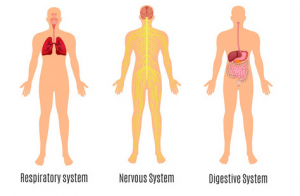Everyone knows that our lungs are the major organ in our respiratory system, that our brain is central to our nervous system and that our stomach and intestines are partners in our digestive system.

How does that connect to organizing? Just look at the word: there is an ORGAN inside organizing!
Our bones — amazing organs within our skeletal system — form the structure of our bodies while they protect our internal organs. With the help of ligaments and tendons, our skeletal system allows us to move.
 Let’s look at our households like our bodies — and see ORGANizing from an interdependent, systemic perspective:
Let’s look at our households like our bodies — and see ORGANizing from an interdependent, systemic perspective:
• providing structure and support
• filtering toxins (clutter)
• creating space for nourishment
• allowing time to digest our days
• minimizing distractions
As the daughter of a D.O., the osteopathic approach always takes the whole person into consideration. Likewise, I consider the whole household when organizing.
 On that note, let’s all head into 2019, protecting our:
On that note, let’s all head into 2019, protecting our:
• organizing time like our brains
• organizing framework as we maintain our posture
• organizing schedule as routinely as brushing our teeth
• and use our ORGANizing muscles to stay healthy!
Happy New Year
NAPO Member, Lauren Mang shares her experience working with a treasured client and how a turn toward Buddhism immersed them in the power and liberation of being present:
I’ve had the pleasure of working with some really wonderful clients, but Katherine really stood out. She worked for years as a successful biochemical scientist and had a lot of wonderful things. After years of this lifestyle, Katherine sought real change. She turned to Buddhism and began not only practicing but teaching it.
Over three sessions, Katherine and I worked together to clear and review items within her condo. Some items Katherine had no attachment to, so the decisions were quick and easy. I was pleasantly surprised when Katherine agreed to let go of 75% of her items.
What I admired most about Katherine was how she handled
items from her ‘past’ life. With each, she’d have same reaction: take a breath, smile, and quietly exclaim, “Wow!” She’d hold the items for a moment, acknowledge their importance and the purpose they served, and then quietly say, “This is a part of my past. I’m ready to let it go.”
Katherine was so immersed in the now that fear and anxiety were not clouding her judgment of materialistic belongings. I said to her, “Katherine, you’ve let go of most of your shoes. Are you sure you don’t want to keep a pair for an evening out?” She thought for a moment before responding, “I think I’d like to treat myself to a new pair.”
Living in the present allows us to realize what we need in the moment. We are not left asking, “What if I need it in two years?” or “What if I finally lose the weight?” The simple answer is, you might not need it in two years (if you do, buy it). Or if you lose the weight, reward yourself with new clothes that you feel great in.
We don’t know what the future will hold, but the universe is ready and willing to provide what you need right now, just lean in. This means letting go of fear of the future, or anxiety/uncertainty over the past. Live in this moment, right now, and watch life become clearer and simple.